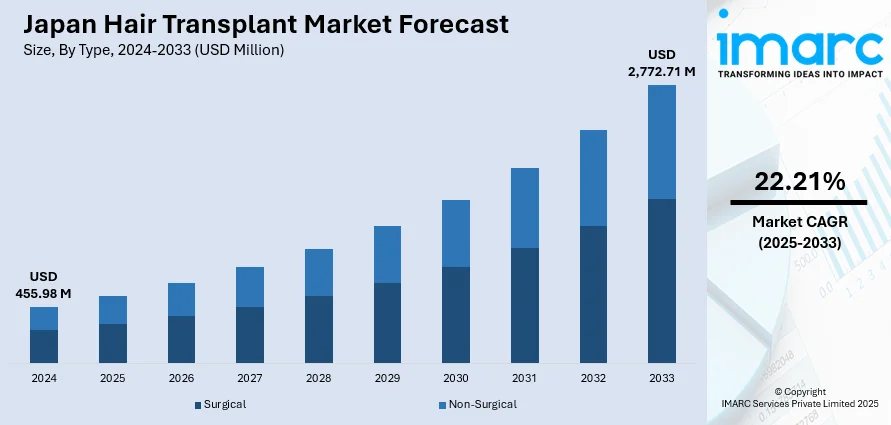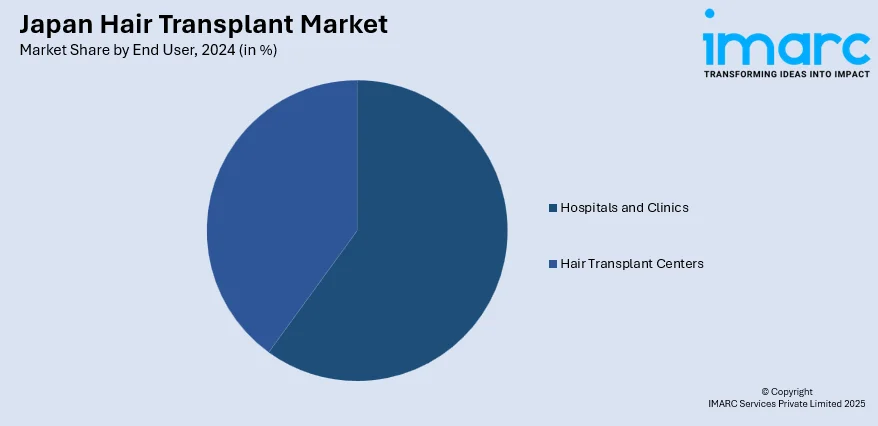
Japan Hair Transplant Market Size, Share, Trends and Forecast by Type, Gender, End User, and Region, 2025-2033
Japan Hair Transplant Market Overview:
The Japan hair transplant market size reached USD 455.98 Million in 2024. Looking forward, IMARC Group expects the market to reach USD 2,772.71 Million by 2033, exhibiting a growth rate (CAGR) of 22.21% during 2025-2033. The market is driven by increasing male acceptance of aesthetic treatments, supported by discreet clinical services and subtle results. Technological innovations, such as AI diagnostics and robotic FUE tools, are improving procedural accuracy and customization, thereby fueling the market. An aging yet image-conscious population is fueling demand for safe, minimally invasive interventions, further augmenting the Japan hair transplant market share.
|
Report Attribute
|
Key Statistics
|
|---|---|
|
Base Year
|
2024 |
|
Forecast Years
|
2025-2033
|
|
Historical Years
|
2019-2024
|
| Market Size in 2024 | USD 455.98 Million |
| Market Forecast in 2033 | USD 2,772.71 Million |
| Market Growth Rate 2025-2033 | 22.21% |
Japan Hair Transplant Market Trends:
Growing Social Acceptance of Aesthetic Procedures Among Men
In Japan, the perception of cosmetic procedures has undergone a significant cultural shift, particularly among men facing hair loss concerns. Traditionally conservative attitudes toward aesthetic enhancement are giving way to greater acceptance, driven by evolving grooming standards and lifestyle changes in urban centers. A recent study analyzed 5,372 Japanese men and found that 85% of men will experience baldness by age 50, with 50% showing visible signs by that age. The study revealed a 4.5-year average for progression between stages on the Norwood-Hamilton scale, with the median age increasing from 26 years for NH classification I to 52 years for NH classification VII. Middle-aged and younger men are increasingly seeking solutions for hereditary or stress-induced alopecia, with hair transplantation emerging as a practical and discreet option. Leading clinics now offer services in professional, low-profile environments, appealing to clients who value privacy and precision. This demographic prioritizes subtle, natural-looking outcomes that do not interfere with their social or corporate identities. Consequently, minimally invasive procedures such as Follicular Unit Extraction (FUE) are favored for their limited downtime and reduced visibility. Moreover, marketing strategies emphasize professionalism, longevity, and technical excellence, qualities that resonate with the Japanese consumer mindset. As this segment grows more confident in clinical solutions to hair loss, the demand for restorative services is expanding beyond metropolitan hubs. These cultural and behavioral shifts are now playing a critical role in Japan hair transplant market growth, aligning aesthetic care with broader wellness and personal branding trends.

Aging Population and Demand for Minimally Invasive Solutions
Japan’s aging population presents a unique dynamic for the hair transplant market, as older individuals increasingly seek aesthetic enhancements that align with active, appearance-conscious lifestyles. Hair loss is a common concern among seniors, but many hesitate to pursue invasive cosmetic interventions due to health considerations. The availability of refined, low-trauma techniques, such as micromotor-assisted FUE, has made hair transplants viable for a broader age group, including patients in their 60s and beyond. The emphasis on safety, hygiene, and clinical reliability aligns well with the expectations of this demographic, who often prioritize functional yet subtle results. In Japan, the male hair loss prevalence stands at 35.69%, with 35% of women also experiencing hair loss. The country's hair care market generated USD 7.17 billion in 2023, reflecting growing demand for treatments. Hair transplants in Japan typically cost around USD 13,610, contributing to the increasing popularity of restorative procedures. Leading clinics have adapted to this demand by offering medical screenings, tailored recovery protocols, and concierge-style follow-up care to address age-related sensitivities. Furthermore, this demographic shift is driving sustained procedural demand beyond the traditionally younger audience, while also influencing how clinics market their services. Hair restoration is increasingly being viewed as a wellness-oriented choice, supporting psychological well-being and self-confidence among older adults. As Japan’s population continues to age, this widening customer base contributes not only to procedure volumes but also to product diversification and service personalization across the country’s aesthetic medical landscape.
Japan Hair Transplant Market Segmentation:
IMARC Group provides an analysis of the key trends in each segment of the market, along with forecasts at the country and regional levels for 2025-2033. Our report has categorized the market based on type, gender, and end user.
Type Insights:
- Surgical
- Non-Surgical
The report has provided a detailed breakup and analysis of the market based on the type. This includes surgical and non-surgical.
Gender Insights:
- Male
- Female
The report has provided a detailed breakup and analysis of the market based on gender. This includes male and female.
End User Insights:

- Hospitals and Clinics
- Hair Transplant Centers
The report has provided a detailed breakup and analysis of the market based on end user. This includes hospitals and clinics and hair transplant centers.
Regional Insights:
- Kanto Region
- Kansai/Kinki Region
- Central/Chubu Region
- Kyushu-Okinawa Region
- Tohoku Region
- Chugoku Region
- Hokkaido Region
- Shikoku Region
The report has also provided a comprehensive analysis of all major regional markets. This includes Kanto Region, Kansai/Kinki Region, Central/Chubu Region, Kyushu-Okinawa Region, Tohoku Region, Chugoku Region, Hokkaido Region, and Shikoku Region.
Competitive Landscape:
The market research report has also provided a comprehensive analysis of the competitive landscape. Competitive analysis such as market structure, key player positioning, top winning strategies, competitive dashboard, and company evaluation quadrant has been covered in the report. Also, detailed profiles of all major companies have been provided.
Japan Hair Transplant Market News:
- On 9th March 2024, Japanese hair care company Aderans signed a licensing agreement with U.S.-based Stemson Therapeutics, granting exclusive intellectual property rights for Aderans' hair restoration research. This collaboration aims to develop treatments for pattern baldness and other hair loss conditions.
Japan Hair Transplant Market Report Coverage:
| Report Features | Details |
|---|---|
| Base Year of the Analysis | 2024 |
| Historical Period | 2019-2024 |
| Forecast Period | 2025-2033 |
| Units | Million USD |
| Scope of the Report |
Exploration of Historical Trends and Market Outlook, Industry Catalysts and Challenges, Segment-Wise Historical and Future Market Assessment:
|
| Types Covered | Surgical, Non-Surgical |
| Genders Covered | Male, Female |
| End Users Covered | Hospital and Clinics, Hair Transplant Centers |
| Regions Covered | Kanto Region, Kansai/Kinki Region, Central/Chubu Region, Kyushu-Okinawa Region, Tohoku Region, Chugoku Region, Hokkaido Region, Shikoku Region |
| Customization Scope | 10% Free Customization |
| Post-Sale Analyst Support | 10-12 Weeks |
| Delivery Format | PDF and Excel through Email (We can also provide the editable version of the report in PPT/Word format on special request) |
Key Questions Answered in This Report:
- How has the Japan hair transplant market performed so far and how will it perform in the coming years?
- What is the breakup of the Japan hair transplant market on the basis of type?
- What is the breakup of the Japan hair transplant market on the basis of gender?
- What is the breakup of the Japan hair transplant market on the basis of end user?
- What is the breakup of the Japan hair transplant market on the basis of region?
- What are the various stages in the value chain of the Japan hair transplant market?
- What are the key driving factors and challenges in the Japan hair transplant market?
- What is the structure of the Japan hair transplant market and who are the key players?
- What is the degree of competition in the Japan hair transplant market?
Key Benefits for Stakeholders:
- IMARC’s industry report offers a comprehensive quantitative analysis of various market segments, historical and current market trends, market forecasts, and dynamics of the Japan hair transplant market from 2019-2033.
- The research report provides the latest information on the market drivers, challenges, and opportunities in the Japan hair transplant market.
- Porter's five forces analysis assist stakeholders in assessing the impact of new entrants, competitive rivalry, supplier power, buyer power, and the threat of substitution. It helps stakeholders to analyze the level of competition within the Japan hair transplant industry and its attractiveness.
- Competitive landscape allows stakeholders to understand their competitive environment and provides an insight into the current positions of key players in the market.
Need more help?
- Speak to our experienced analysts for insights on the current market scenarios.
- Include additional segments and countries to customize the report as per your requirement.
- Gain an unparalleled competitive advantage in your domain by understanding how to utilize the report and positively impacting your operations and revenue.
- For further assistance, please connect with our analysts.
 Request Customization
Request Customization
 Speak to an Analyst
Speak to an Analyst
 Request Brochure
Request Brochure
 Inquire Before Buying
Inquire Before Buying




.webp)




.webp)












